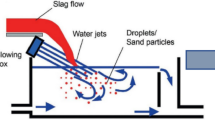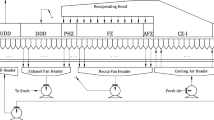Abstract
Sinter is one of the important inputs to Blast Furnace. Iron ore sintering process is dominating the agglomeration process in Steel manufacturing sector. To achieve good quality sinter, it is required to know the change in temperature with time for a particular segment of sinter bed. As sintering takes place in moving grate sinter machine this is difficult to achieve in real time. In this paper, in situ temperature measurement across the sinter bed has been carried out by special arrangement of thermocouples in moving grate. Parameters derived from the time–temperature curve have been related to sinter process parameters. Predictions of sinter strength (tumbler index), coke ratio and other important parameters have been proposed in this paper from time–temperature curve, obtained. Interpolation helps mostly to ascertain the relationship between parameters obtained from temperature time curve and sinter quality. Also, prediction of Burn Through Point by sinter bed temperature was done by two parameters namely regression coefficient and time delay between the peaks of sinter bed temperature and wind box temperatures. Sintering process may be automated from quality point by in situ temperature measurement after prediction with excellent correlation and minimum time delay.






















Similar content being viewed by others
References
Zhi-kun C, Yu-tian W, and Fu-bin W, The Research of Control for Sintering Burn-Through Point Based on Finite-State Machine, In Proceedings of the 2011 International Conference on Electric Information and Control Engineering (ICEICE), Wuhan, China, 15–17 April 2011; pp. 1830–1833.
Nath N K, and Mitra K, Optimisation of suction pressure for iron ore sintering by genetic algorithm. Ironmak. Steelmak. 31 (2004) 199–206. https://doi.org/10.1179/030192304225018118
Toda H, Senzaki T, Isozaki S, and Kato K, Relationship between heat pattern in sintering bed and sinter properties. Trans. Iron Steel Inst. Jpn. 24 (1984) 187–196.
Toda H, and Kato K, Theoretical Investigation of Sintering Process. Trans. Iron Steel Inst. Jpn. 24 (1984) 178–186.
Rub´en U, Julio M, Garcia D F, Bulnes F G, Monitoring Sintering Burn-Through Point Using Infrared Thermography, Sensors, 13(2013), 10287–10305. doi:https://doi.org/10.3390/s130810287
Machida S, Higuchi T, Oyama N, Sato H, and Tamura K, Optimization of Coke Breeze Segregation in Sintering Bed under High Pisolite Ore Ratio. ISIJ Int. 49 (2009) 667–675.
Kasai E, Komarov S, Nushiro K, and Nakano M, Design of bed structure aiming the control of void structure formed in the sinter cake. ISIJ Int. 45 (2005) 538–543.
Ishiyama O, Hara K, Matsumura M, Higuchi K and Nomura S, Tetsu-to-Hagané, 103 (2017), 564–569. (in Japanese). https://doi.org/10.2355/tetsutohagane.TETSU-2017-007
Touitou J, Burch R, Hardacre C, McManus C, and Goguet A, ‘An in situ spatially resolved analytical technique to simultaneously probe gas phase reactions and temperature within the packed bed of a plug flow reactor’, Analyst, 138 (2013), 2858-2862. https://doi.org/10.1039/C3AN00250K
Touitou J, Aiouache F, Burch R, Douglas R, and Goguet A, Evaluation of an in situ spatial resolution instrument for fixed beds through the assessment of the invasiveness of probes and a comparison with a micro-kinetic model. J. Catal. 319 (2014) 239–246. https://doi.org/10.1016/j.jcat.2014.09.006
SAIZ Jesús and POSADA Maria José, Non-linear State Estimator for the On-line Control of a Sinter Plant. ISIJ International 53 (2013) 1658–1664. https://doi.org/10.2355/isijinternational.53.1658
Venkataramana R, Gupta S S, Kapur P C and Ramachandran N, Mathematical Modelling and Simulation of the Iron Ore Sintering Process, Tata Search, (1998), 50–55. https://www.researchgate.net/profile/Venkataramana-Runkana/publication/302499155_Mathematical_Modelling_and_Simulation_of_the_Iron_Ore_Sintering_Process/links/5f8a814c458515b7cf85337f/Mathematical-Modelling-and-Simulation-of-the-Iron-Ore-Sintering-Process.pdf
Chen X L, Fan X H, Wang Y, Long H M, and Yang X D, Control guidance system for sintering burn through point. Ironmaking and Steelmaking 36 (2009) 209–211. https://doi.org/10.1179/174328107X155367
Final project report of “Development of an online sinter bed temperature measurement for Sinter Plants”, NDTS/ABP/576/2015. https://corpsys.corp.tatasteel.com/gpms/RD003.aspx?C=4255, accessed on 31st October, 2022
Tupkary R H, and Tupkary V R, An Introduction to Modern Iron Making, 4th edn. KHANNA PUBLISHERS, Delhi, Fourth Reprint (2014).
Loo C E, Tame N, and Penny G C, Effect of Iron Ores and Sintering Conditions on Flame Front Properties. ISIJ International 52 (2012) 967–976. https://doi.org/10.2355/isijinternational.52.967
Loo C E and Dukino R D, Laboratory iron ore sintering studies. 3. Critical heat transfer period, Mineral Processing and Extractive Metallurgy (Trans. Inst. Min. Metall. C), 123(2014), 204–211. https://doi.org/10.1179/1743285514Y.0000000066
Staiz J and Jose P M, Non-linear state Estimators for the on-line Control of sinter plant, ISIJ international, 53 (2013), 1658–1164.http://dx.doi.org/https://doi.org/10.2355/isijinternational.53.1658
Chun S W, and Min W U, Closed-Loop Identification Method Of Sintering Process With Part Of The Inputs Controlled. Procedia Engineering 15 (2011) 1910–1915. https://doi.org/10.1016/j.proeng.2011.08.356
Hyun K W, Ho K Y, Jeong L S, and Ki-Nam P, Event based modelling and control for the burning point in sintering process. IEEE transaction on Control Systems Technology 7 (1999) 31–41. https://doi.org/10.1109/87.736747
Acknowledgements
The authors would like to thank Mr. Yatin K. Sawant, R&D and SP#1 team for contribution towards this work.
Author information
Authors and Affiliations
Corresponding author
Additional information
Publisher's Note
Springer Nature remains neutral with regard to jurisdictional claims in published maps and institutional affiliations.
Rights and permissions
Springer Nature or its licensor (e.g. a society or other partner) holds exclusive rights to this article under a publishing agreement with the author(s) or other rightsholder(s); author self-archiving of the accepted manuscript version of this article is solely governed by the terms of such publishing agreement and applicable law.
About this article
Cite this article
Ray, T., Mitra, D., Mukherjee, A. et al. In Situ Temperature Measurement Across the Sinter Bed. Trans Indian Inst Met 76, 1175–1189 (2023). https://doi.org/10.1007/s12666-022-02830-z
Received:
Accepted:
Published:
Issue Date:
DOI: https://doi.org/10.1007/s12666-022-02830-z




